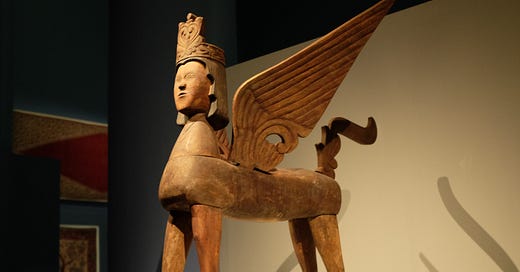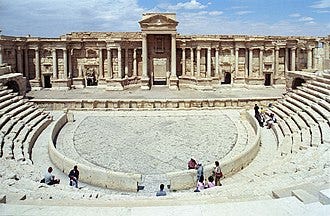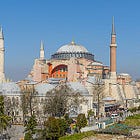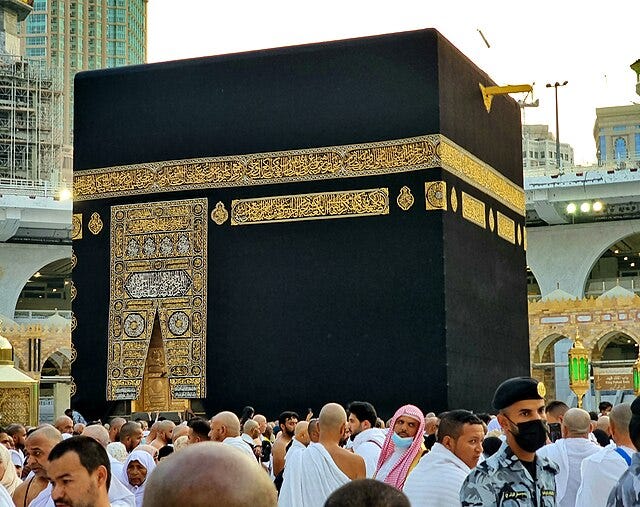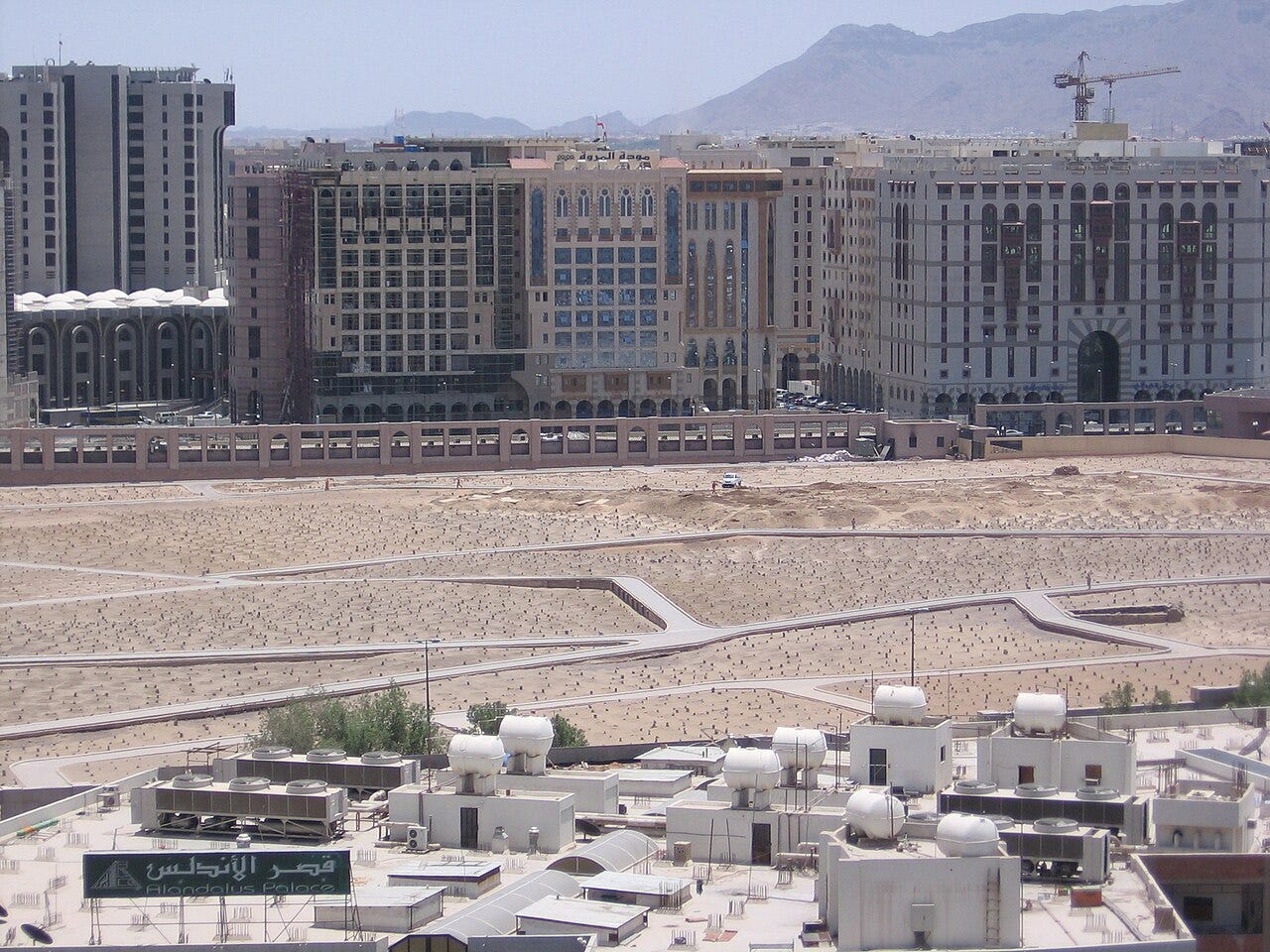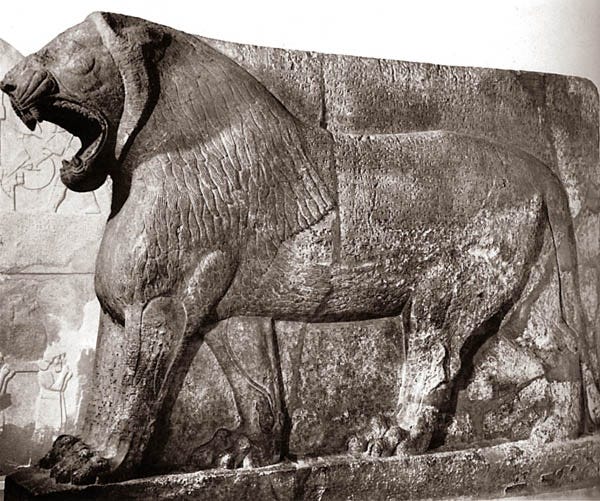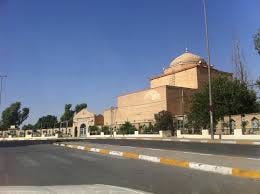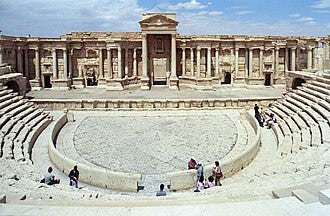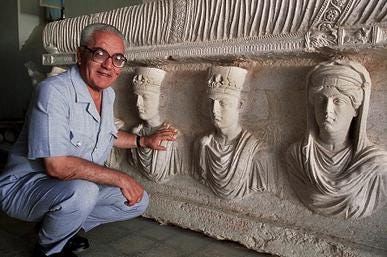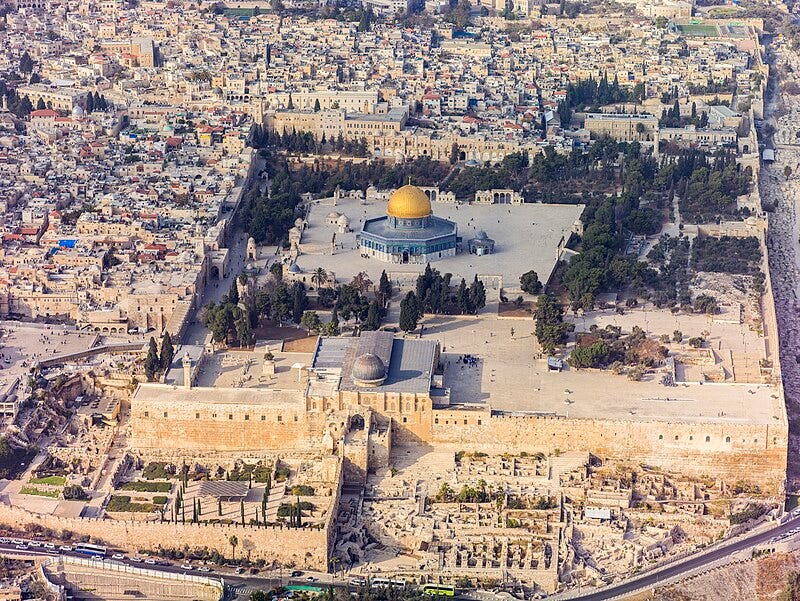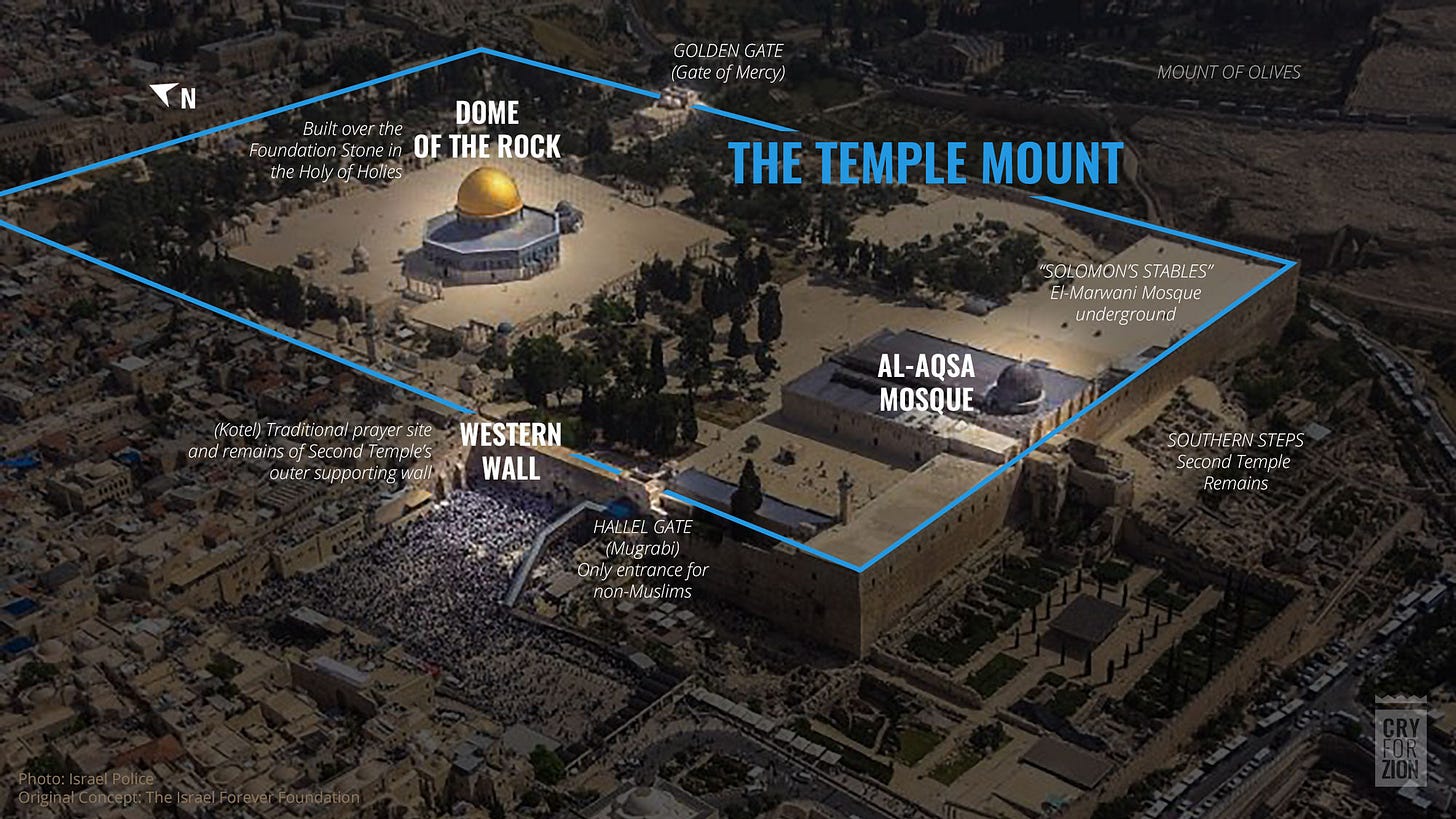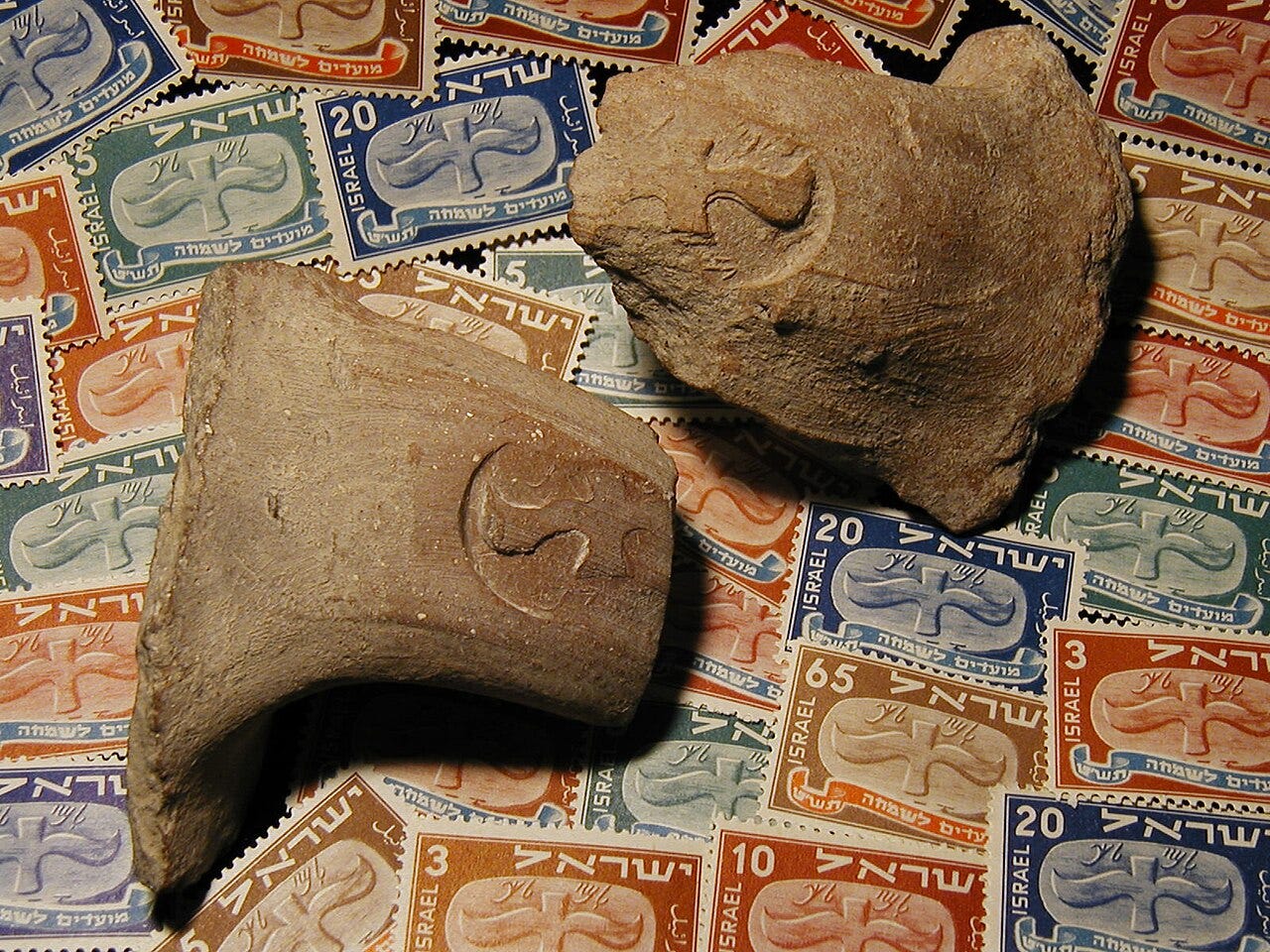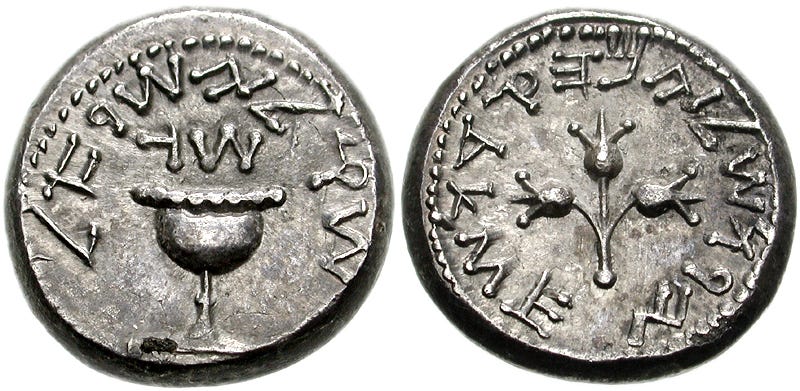Why Doesn't Modern Islam Value the Past?
Islam used to acknowledge the past, but now just want to destroy, and forget it.
Last time I finished up my posts on the worrying positions Turkey is taking and how it could affect their membership in NATO. Click the link below if you missed it.
Today I want to write about something that I kept thinking about while doing research into the Hagia Sophia in Turkey. It is also something I’ve thought about in regards to Jerusalem and the Temple Mount. Why does modern Islam seem to have no regard for any history that happened before Islam was founded, and sometimes even their own history?
Also, just to let everyone know I don’t like the abbreviations CE (common era), and BCE (before common era). I much prefer AD (anno domini-in the year of our Lord), and BC (before Christ) it is just what I heard growing up and it just sounds better. So I will be using them a lot during this post.
Up first, a little history
According to the Quran and Islamic scholars, Muhammad was born in the city of Mecca, in what is now Saudi Arabia, in the year 570 AD. In the year 610 AD, when he was 40, Muhammad received the first of what would be many visits from the angel Gabriel giving him the beginnings of what would become the Quran. In 621 AD it is said that Muhammad traveled from Mecca to Jerusalem on the back of Buraq (a winged horse, with a human face), where he led other prophets including Ibrahim (Abraham), Musa (Moses) and Isa (Jesus) in prayer. Muhammad then ascended into heaven where he spoke with God. God told him that the faithful must pray 50 times a day, but after talking with Musa, Muhammad went back to God and asked for a smaller number of prayers. After several of these back and forth discussions, Muhammad and God were able to settle on five prayers a day, Musa told Muhammad to ask for one prayer a day, but Muhammad was too embarrassed to go back another time, and five prayers is the number to this day, (I’m not kidding, that is what they say really happened, it’s in the Quran).
The holiest site in Islam, the Kaaba in Mecca, was revered as a sacred sanctuary for the animists and polytheists, long before Islam. The Kaaba contained hundreds of idols representing Arabian tribal gods and other religious figures, including Christian and Jewish ones, it was neutral ground where all the tribes would come to worship their gods, without worrying about inter-tribal violence. In 630 AD when Muhammad conquered Mecca, his first action was to remove the statues and images from the Kaaba and dedicate it to the worship of Allah. According to reports collected by 8th century historian and biographer of Muhammad, Ibn Ishaq, and 9th century historian al-Azraqi, the only items not destroyed by Muhammad were a painting of Mary and Jesus and a fresco of Abraham. By his death in 632 AD, Muhammad had converted, nearly all of the Arabian Peninsula to Islam, either by choice or by the sword.
When Muhammad died the choice of who would succeed him was the cause of the split between Sunni and Shi’a Islam. Sunnīs believed the caliph was an elected role and any Muslim from the clan of Quraysh, the tribe of Muhammad, could be elected. Shiites, on the other hand, believed the title of caliph was a hereditary title and should remain within the bloodline of Muhammad. Therefore, Shiites believe all the caliphs, with the exceptions of Muhammad's cousin and son-in-law Ali ibn Talib and his firstborn son Hasan were illegitimate usurpers.
Throughout history, Islam and its various caliphates have ruled territory from Portugal and Morocco in the west, Romania, parts of Hungry, to parts of India and Afghanistan in the east. There have been many different leaders and thinkers in Islam and for the large majority of that history most of them, at least, recognized pre-Islamic history. Of course, there were many times where Muslim conquerors repurposed a church or other pre-existing building into a mosque. When Mehmed II conquered Constantinople in 1453, he ordered that the Hagia Sophia be renovated, actually preserving the Byzantine mosaics, which had been in a state of disrepair.
Wahhabism
When we start to see a disconnect between Muslims and previous history begins with the advent of Wahhabism. It is a reformist movement within Sunni Islam, based on the teachings of 18th-century cleric Muhammad ibn ‘Abd al-Wahhab (1703-1792). It began in the central Arabian Peninsula before spreading to other areas of Arabia. The Wahhabi movement opposed rituals related to the veneration of Muslim saints and pilgrimages to their tombs and shrines, which were widespread amongst the people, especially the Sunnis. Ibn 'Abd al-Wahhab and his followers were highly inspired by the scholar ibn Taymiyyah (1263–1328) who advocated for a return to the purity of the first three generations of Islam. The pivotal idea in Ibn Wahhabi’s teachings is that Muslims who disagreed with his definition of monotheism were not misguided Muslims, but outside the bounds of Islam altogether. This put al-Wahhab's teaching at odds with that of most Muslims who argued that the “shahada” (i.e. the testimony of faith; "There is no god but God, Muhammad is his messenger") alone made one a Muslim, and that shortcomings in that person's behavior and performance of other obligatory rituals rendered them "a sinner", but "not an unbeliever". Muhammad ibn Abd al-Wahhab did not accept that view. He argued that one's standing as either a Muslim or an unbeliever was correct worship, as an expression of belief in one God. Any act or statement that indicates devotion to a being other than God is to associate another creature with God's power, and that is tantamount to idolatry. al-Wahhab included in that category, religious practices that made holy men into intercessors with God as well as the practice of venerating Islamic “saints” and visiting their tombs, including the tomb of Muhammad himself.
Beginning the destruction
The first major act of destruction conducted by Wahhabists was the sacking of Karbala in 1802. Abdulaziz bin Muhammad al-Saud (his bloodline would become the ruling family and namesake of Saudi Arabia), and 12,000 Wahhabis, attacked and sacked the Shiite city of Karbala in modern Iraq. The Wahhabis killed 3,500 of the inhabitants and plundered the tomb of Husayn ibn Ali, grandson of the Prophet Muhammad and son of the Fourth Caliph Ali ibn Abi Talib. The dome of the tomb was destroyed and a large quantity of spoils including gold, money and guns, that had been offerings from the faithful were taken back to Arabia, on 4,000 camels.
In 1806 with most of the west coast of the Arabian Peninsula, including Mecca and Medina, under the control of al-Saud and his Wahhabists, the Sauds attempted to create obstacles to prevent non-Wahhabi Muslims from performing the Hajj (the annual pilgrimage required of all Muslims at least once in their lives). Over the next few years, they gradually increased the duty paid to complete the Hajj. They also banned pilgrims from bringing musical instruments and mahmal (richly decorated ceremonial passenger-less litters that were carried on camels among the caravans), both of which were often brought by pilgrims, but incompatible with Wahhabi religious standards. They also later barred "boys or other beardless persons”. In 1805, Iraqi and Iranian Muslims were not allowed to perform Hajj and in 1806 Syrians and Egyptians were refused permission to perform the Hajj.
After tightening restrictions on who could perform the Hajj, the Wahhabists targeted the al-Baqi Cemetery in Medina. The cemetery was thought to have been founded by Muhammad himself. People buried at al-Baqi include all eleven of Muhammad’s wives, his four daughters, his infant son Ibrahim, his grandson Hasan, his great grandson Ali, four Shia Imams and many of the Companions of Muhammad (a group of 50 or 60 people that followed him during his lifetime), including Uthman ibn Maz'un, the first companion. There are many Islamic texts that Muhammad visited this cemetery regularly to pray for God's forgiveness for those buried there. Many of the tombs were elaborate and highly decorated, both things that would draw the ire of the Wahhabists. in 1806 the smaller tombs were plundered and raised to the ground. They were even going to destroy the tomb of Muhammad, but settled for stripping it of all its gold and other decorations. In 1814 the Ottomans, who were nominally in control of all of the Arabian Peninsula, drove al-Saud and his Wahhabists away from Mecca and Medina back into the interior.
However, on April 21, 1925, after a ruling by Islamic judge (or Qadi) Abd Allah ibn Bulayhid, that the cemetery and other buildings in Medina were leading Muslims into idolatry. The mausoleums, domes and graves at al-Baqi that had survived the 1806 destruction, or had been rebuilt, were again the focus of an attack by Wahhabists led by a Saud, this time Ibn Saud (who in 1932, would be crowned the first King of Saudi Arabia). This time, everything in the cemetery was leveled, including the simplest gravestones as well as the signs indicating the exact location of the resting places of Muhammad's family members and descendants. They also destroyed the graves of the Martyrs of the Battle of Uhud, the grave of Hamza in al-Muttalib, the uncle and one of the most beloved supporters of Muhammad, the Mosque of Fatimah Al Zahraa', daughter of Muhammad, as well as the Qubbat Al-Thanaya, the cupola built as the burial place of Muhammad's incisor tooth, which had been knocked out during the Battle of Uhud. Portions of the famed Qasida al-Burda, the 13th century ode in praise of Muhammad written by Imamoglu al-Busiri, which was inscribed over Muhammad’s tomb were painted over, but once again, the tomb itself was saved by intense pressure from the rest of the Islamic world. British convert Eldon Rutter compared the demolition to an earthquake: "All over the cemetery nothing was to be seen but little indefinite mounds of earth, stones, pieces of timber, iron bars, blocks of stone, and broken rubble of cement and bricks, strewn about.” The site of the cemetery was eventually paved over and is today part of the massive marble esplanade beside the al-Masjid al-Nabawī mosque.
The twenty-first century has seen an increase in the demolition of sites in Mecca and Medina by Saudi authorities, alongside expansion of luxury development. While there is widespread agreement for the need of facilities that can accommodate greater numbers of pilgrims, the development of upscale hotels and condominium towers, restaurants, shopping centers and spas has caused some to criticize the over-commercialization of a site which many consider to be a divinely ordained sanctuary for Muslims. The House of Mawalid, where Muhammad is said to have been born is about to be replaced by a huge royal palace, as a part of a multibillion-dollar construction project in Mecca.
In 632, the year Muhammad died, Xuanzang, a Chinese traveler (maybe, one of the first travel writers), writes about two huge statues of Buddha carved out of a mountainside in the Bamiyan Valley in Afghanistan. They were carved in 618 and Muslims tried to destroy the statues four different times before they were completely obliterated by the Taliban in 2001.
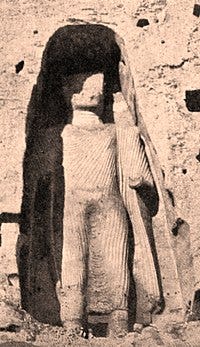
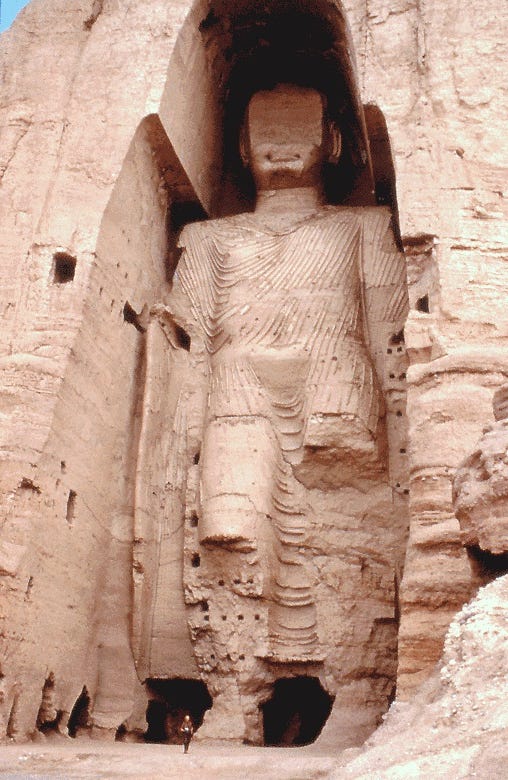
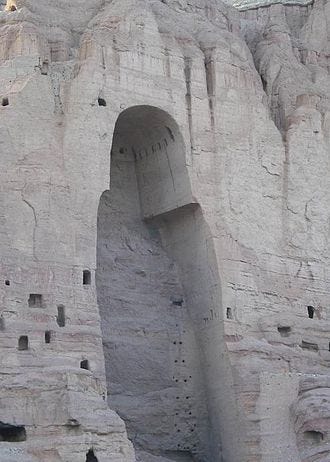
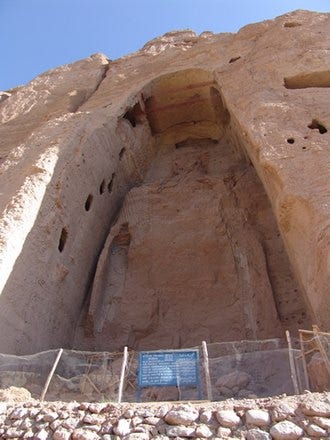
ISIS: the evil destroyer
The Saudis aren’t the only Muslim group destroying ancient sites. ISIS (Islamic State of Iraq and Syria) is well-known for destroying anything that doesn’t fit into their narrow vision of Islam.
ISIS is a international Salafi Jihadist, (a Sunni ideology that seeks to establish a global caliphate through military means), group. Their origins were in the Jaish al-Ta’ifa al-Mansurah organization founded by Abu Omar al-Baghdadi and Abu Musab al-Zarqawi in 2004 in Iraq. The organization was originally affiliated with Al-Qaeda but split with them over a perceived lack of determination to bring about a new caliphate. They gained global prominence in 2014, when their militants successfully captured large areas of northwestern Iraq and eastern Syria, during the Syrian civil war. Notorious for their war crimes and extensive human rights violations, as well as publishing videos of beheadings and executions of journalists and aid workers. ISIS have engaged in the persecution of Christians, Caldeans, Mandaeans, Shia Muslims and those Sunni Muslims that don’t adhere to their violent belief system.
In May 2014, ISIS fighters smashed a 3,000 year-old statute from the former Assyrian town of Saddikami, now called Tel Ajaja. Later reports indicated that 43% of the artifacts from Tel Ajaja were looted by ISIS. These and other looted ancient artifacts were sold on the black market to finance ISIS operations.
In the Syrian city of Raqqa, the ISIS “capital”, ISIS eradicated two colossal 8th century Assyrian lion sculptures, known as lamassu, from the Arslan Tash archaeological site. A story, accompanied by photos, of the destruction was published in the ISIS magazine, Dabiq.
In June 2014, it was reported that ISIS fighters had received orders to destroy all churches in Mosul. In July 2014, The Virgin Mary Church was destroyed. In August, Dair Mar Elia, the oldest monastery in Iraq, was demolished. In early 2015, the Al-Tahera Church, built in the early 20th century, was blown up. In March 2015, the St Markourkas Church, a 10th-century Chaldean Catholic church and a nearby cemetery were destroyed.
In July 2014, there were many reports of the destruction of multiple religious sites belonging to both Sunni and Shia sects throughout areas captured by ISIS. In Mosul, they destroyed one of the tombs of the prophet Daniel, (apparently he has many tombs, two in Iran, two in Iraq, two in Turkey, one in Uzbekistan and one in Morocco. He really got around), the tomb and mosque of the prophet Jonah (yes, the one that was swallowed by a whale), the tomb of Saint George, the Imam Abbas Mosque and the Mausoleum of Imam Awn Al-Din. In Tal Afar, they destroyed the Sheikh Jawad Al-Sadiq Mosque, the Qaddo Mosque, the Martyrs’ Mosque and the Saad Ibn Aqeel Shrine. In Al-Rifai the Ahmed al-Rifai Shrine and the Sheikh Ibrahim Shrine were destroyed.
In September 2014, ISIS also blew up or demolished a number of other churches elsewhere in Iraq or in Syria, including the Armenian Genocide Memorial Church in Deir ez-Zor, Syria
Also in September 2014, the Al-Arba’eem Mosque in Tikrit was blown up, destroying the mosque as well as 40 tombs from the time of the second caliph Omar. Shrines dedicated to Sitt Nafisa, (the great, great granddaughter of Muhammad and early Sunni teacher) and Amr ibn Jundab al-Ghafari (the fifth person converted to Islam and a close companion of Muhammad), were also destroyed.
In January 2015, ISIS destroyed large parts of the Nineveh Wall in Mosul. Additional areas of the walls, including the Mashka and Adad Gates were obliterated in April 2016.
In February 26, 2015, ISIS blew up the 12th century Green Mosque in central Mosul and released a video showing the destruction of various ancient artifacts in the Mosul Museum. Most of the artifacts were from the ancient Assyrian city of Hata, the video shows a jackhammer being used to deface a granite lamassu.
In March of that year, they destroyed the 19th century Hamu Al-Qadu Mosque also in Mosul. They also ordered the removal of all decorative elements and frescoes from mosques in Mosul, even those containing Quranic verses that mention Allah. They were described as "an erroneous form of creativity, contradicting the basics of sharia”. At least one Imam in Mosul who opposed that order was executed by ISIS.
In March 2015, the Mar Behnam Monastery, which was built in the 4th century by Assyrian king Senchareb as penance for martyring his son Mar Behnam and daughter Sarah after they converted to Christianity, was vandalized by ISIS. The tomb of Mar Benhnam was heavily damaged, the exterior murals were desecrated on all of the monastery's buildings. ISIS also removed all the crosses from the monastery, threatened the monks with execution and then expelled the monks with nothing but the clothes on their backs.
On March 5, 2015, ISIS began the demolition of Nimrud, an Assyrian city founded in the 13th century BC. The palace of Ashurnasirpal II was bulldozed, and lamassu statues at the gates were smashed. By the time the city was retaken by government forces, 90% of the excavated zone of Nimrud, including Ashurbanipal II's palace, the ziggurat, and its lamassu statues had been completely destroyed. Since the city's destruction, The Nimrud Rescue Project, funded by the Smithsonian, has worked to train local archaeologists to protect and conserve the remains. So far the project has largely been successful in documenting and collecting the remaining artifacts and reliefs; plans for reconstruction are also in the works.
On Easter day April, 5 2015, as forces of the Kurdish People's Protection Units and anti-ISIS Syrian fighters entered the Syrian town of Tel Nasri, ISIS destroyed the Assyrian Christian Church of the Virgin Mary.
On April 8, 2015, the Iraqi Tourism and Antiquities Ministry reported that ISIS had destroyed the remnants of the 12th-century Bash Tapia Castle in Mosul and that 20% of Iraq’s 10,000 archaeological sites were under IS control.
In anticipation of the capture of Palmyra by ISIS, archaeologists removed hundreds of artifacts from the Palmyra Museum. The city of Palmyra, (in modern Syria), which had been built around the year 2000 BC. The city was abandoned in 1633 but was still under Muslim control until the Ottoman Empire surrendered after World War I. In 2013, during the Syrian civil war, the facade of the Temple of Baal sustained significant damage from mortar fire, and some of the colonnade columns were damaged by shrapnel. According to Maamoun Abdulkarim, Director of Antiquities and Museums at the Syrian Ministry of Culture, the Syrian Army positioned its troops in some archaeological-site areas, while Syrian opposition fighters positioned themselves in gardens around the city.
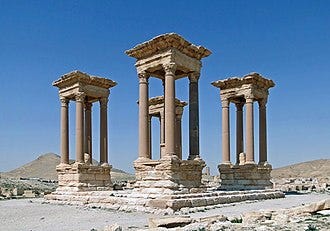
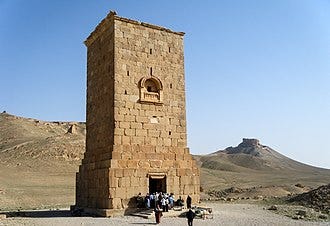
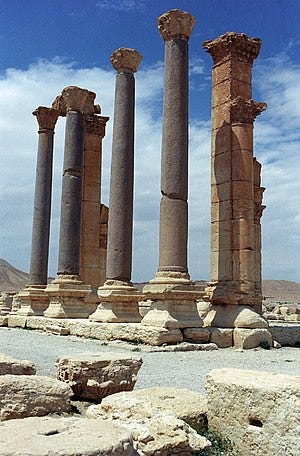
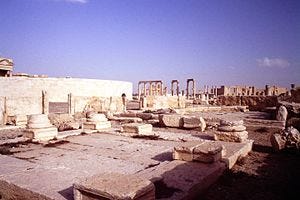
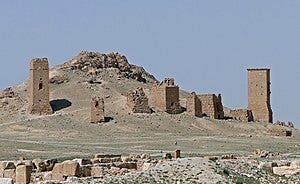
On May 21, 2015, ISIS entered Palmyra, ISIS stated they were not intending to demolish the World Heritage Site (while still intending to destroy any statues deemed “polytheistic”).
On May 27, 2015, they released an 87-second video showing parts of the apparently undamaged ancient colonnades, the Temple of Baal and the Roman theater. In June 2015, ISIS released a video showing its members executing twenty-five captured Syrian soldiers at the amphitheater, observed by hundreds of local civilian men, who were forced to watch.
On June 27, 2015, ISIS demolished the ancient Lion of Al-lat, It has since been restored, and is in storage in a Damascus museum until it can be safely returned to Palmyra. Several other statues from Palmyra that had been seized by ISIS from an antiques smuggler were also destroyed.
On August 18, after being tortured for a month to reveal the location of Palmyra's treasures, retired antiquities chief Khaled al-Asaad, (no relation to the Syrian ruling family), was beheaded and his body hung from a traffic light by ISIS after he refused to give them any information.
On August 23, 2015, ISIS blew up the 1st century Temple of Baalshamin (a Canaanite sky god) and on August 30, demolished the Temple of Baal (the Babylonian king of the gods). Satellite imagery of the site taken shortly after showed almost nothing remained.
Between August 27, and September 2, 2015, ISIS also destroyed seven ancient tower tombs in Palmyra, including the destruction of the 2nd-century AD Tower of Elahbel, which had been called “the most prominent example of Palmyra's distinct funerary monuments.
On August 31, 2015, ISIS destroyed the historic St. Elijah's Monastery near the town of Al-Qaryatan.
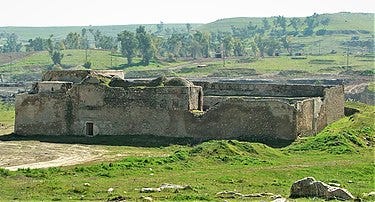
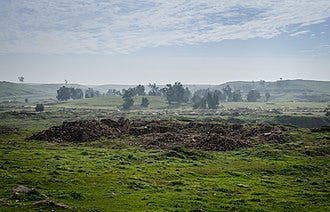
In November 2016, ISIS destroyed the Minaret of Anah in Al-Anbar Province. Its construction was completed in 1096 AD and had just been rebuilt after being destroyed in 2006 during the Iraq civil war.
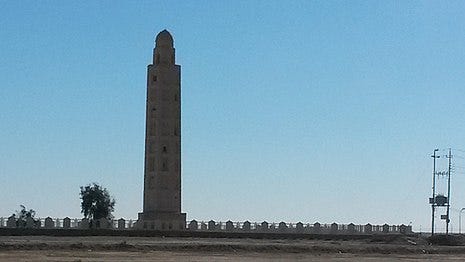
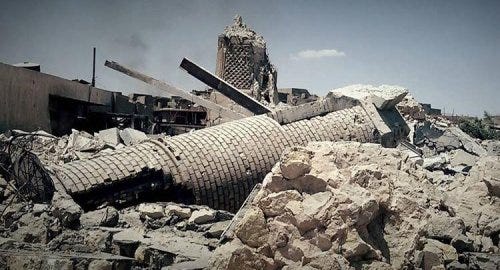
In 2017, ISIS destroyed the Great Mosque of al-Nuri and its leaning minaret. This was the mosque where ISIS leader Abu Bakr al-Baghdadi declared the establishment of the Islamic State caliphate three years prior.
In January 2017, during their second occupation of Palmyra, ISIS destroyed the facade of the Roman theater as well as a tetrapylon (a Roman rectangular monument with arched passages in two directions, at right angles, generally built on a crossroads).
ISIS also burned or stole collections of books and papers from various locations, including the Central Library of Mosul, which was burned to the ground, the Mosul University Library, the Mosul Museum Library, a Sunni Muslim library, and the library of the 265-year-old Latin Church and Monastery of the Dominican Fathers. Some of the destroyed or stolen works dated back to 5000 BC, others include Iraq newspapers dating to the early 20th century, maps and books from the Ottoman Empire, and book collections contributed by about 100 of Mosul's establishment families. ISIS stated that the goal was to destroy all non-Islamic books.
The denial of history
Along with the destruction of historical monuments, modern Islam seems to be in denial of the history that came before them, especially by the Palestinians on the Temple Mount. They hold that there is no evidence for either temple ever existing in Jerusalem. First, we have to establish who is in charge of the Temple Mount and then we can look at what evidence has been found.
The Waqf
There would be much more evidence for both temples if the Jerusalem Waqf and Al-Aqsa Mosque Affairs Department, known simply as the Waqf, would allow archaeological excavations in the area. The Waqf, which in Islamic law, is a building, plot of land or other property that has been dedicated for Muslim religious or charitable purposes, has been in place since Muslims conquered Jerusalem in 1187. The current Waqf is actually administered by the Jordanian Ministry of Awqaf Islamic Affairs and Holy Place, which is charged with "implementing the Hashemite (the royal family of Jordan) custodianship over Islamic and Christian holy sites and endowments and consolidating the historical and legal status quo." The staff members of the Jerusalem Waqf are employees of the Jordanian government. It is headed by a director, also picked by the Jordanian government, the current director of the Jerusalem Waqf is Sheikh Azzam al-Khatib, appointed in 2005. When Israel recaptured the eastern half of Jerusalem in 1967, they made an agreement to allow the Jordanian religious authorities to retain control of the Temple Mount.
Since the Waqf considers Jewish prayers (or any non-Muslim prayers) to be an affront to Islam, they forbid anyone but Muslims to recite prayers on the Temple Mount. The Waqf is frequently accused of the careless destruction of cultural artifacts below the Temple Mount. The Waqf has also been accused by archaeologists and scholars of deliberately trying to obliterate evidence of Jewish history and Israel's Supreme Court has held that the Waqf has damaged and destroyed important archaeological remains on the Temple Mount. That is the plan the Waqf has, do not allow any digging on the Temple Mount, (which I can understand), or anywhere near it, (which I can’t), to stop any evidence of either temple coming to light. The Waqf has also taken advantage of the situation to unilaterally make changes to the composition and use of the Temple Mount.
41 feet below the southwest corner of the Temple Mount is a vaulted area 600 square yards in size, supported by 12 rows of pillars and arches. It was most probably a storage area during the temple periods, and was converted into a stable by the Knights Templar during the Kingdom of Jerusalem (1099-1187) and was known, from then, until recently, as Solomon’s Stables. In the winter of 1996 the Waqf acquired a permit to use Solomon's Stables as an alternative place of worship for occasional rainy days during Ramadan. Later the Waqf declared that it aimed to create a mosque for 10,000 worshippers, which would make it the largest mosque in the country. This move was obviously designed to strengthen the Muslim claim over the Temple Mount. The Committee for the Prevention of Destruction of Antiquities on the Temple Mount, a group of Israeli archeologists, stated that construction of the new mosque was an attempt by the Waqf to remove archeological evidence that a temple ever stood at the Temple Mount. Shortly thereafter, the Waqf began digging a huge hole in the southeastern area of the Temple Mount, without a permit or archaeological supervision, while using bulldozers and other heavy equipment. This drew more criticism from archaeologists, who said that archaeological strata and artifacts were being damaged in the process and the excavations weakened the stability of the Southern Wall. In December 1996 the new mosque was officially inaugurated as Al-Marwani Mosque. In 1999, construction began on an emergency exit for the mosque. In doing so, bulldozers dug a pit more than 131 feet long and nearly 40 feet deep, with trucks carting away hundreds of tons of soil and debris from the area. In order to preserve the archaeological integrity of the site, the soil that had been carted away was reclaimed by Israeli archaeologists, and the Temple Mount Sifting Project was born.
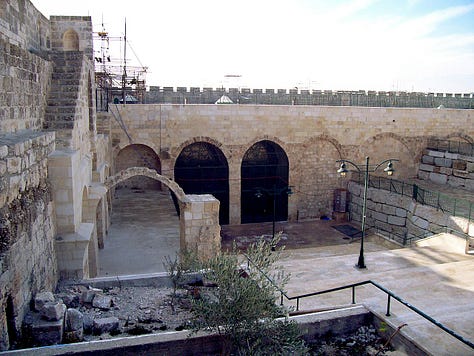
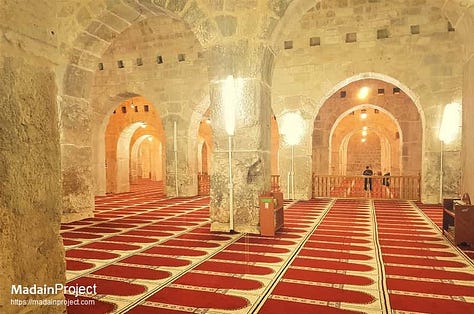
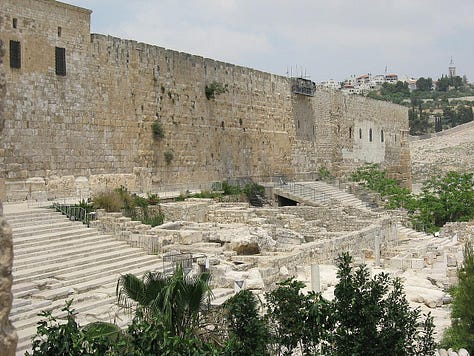
The fears of Israeli archaeologists proved true, when in September 2002, there was a large visible bulge in the Southern Wall. The bulge threatened the structural integrity of the Temple Mount, it was feared that part of the wall could seriously deteriorate or even collapse. The Waqf would not permit detailed Israeli inspection but came to an agreement with Israel that a team of Jordanian engineers would inspect the wall in October 2002. They recommended repair work that involved replacing or resetting most of the stones in the affected area, which covers 2,000 square feet, 25 feet from the top of the wall. Repairs were completed by January 2004. The repairs have been called "unsightly" because they appear as a large, bright, white patch of smooth stones in a golden tan wall of rusticated stone.
The First Temple
The Waqf, Palestinian Authority and Palestinians in general, do not believe that any Jewish temple ever stood on what they call Haram al-Sharif (the Noble Sanctuary). However, the Temple Mount Sifting Project found a LMLK seal (LMLK is an abbreviation meaning 'of the king' in Hebrew and are seals stamped on the handles of large storage jars) from the reign of King Hezekiah (reigned from 716-686 BC) and several sealing bullae (a kind of clay seal, like the wax seals used on letters into the 19th century), the most prominent among them being a broken seal bearing the incomplete given name …lyahu and the family name Immer, the name of a well known Biblical priestly family, also dating to the 6th and 7th century BC. An arrowhead from the army of Nebuchadnezzar II was also found. Nebuchadnezzar II was the Babylonian king who destroyed the First Temple and deportation of most Jews to Babylon. Seems like significant evidence of the existence of the First Temple to me.
The Second Temple
There is even more evidence of the Second Temple. In 1871, British archaeologist Charles Simon Clermont-Ganneau discovered a hewn stone measuring 24 in × 35 in, and engraved in Greek. It was discovered near a court on the Temple Mount and identified as being the Temple Warning inscription. The stone inscription outlined the prohibition extended to those who were not of the Jewish nation to proceed beyond the soreg separating the larger Court of the Gentiles and the inner courts. It reads:
No stranger is to enter within the balustrade round the temple and enclosure. Whoever is caught will be himself responsible for his ensuing death.
The Temple Mount Shifting Project also found thousands of pieces of pottery and other items relating to the Second Temple Period. Over 40% of the pottery found date from 516 BC to 70 AD with 2/3 of it coming from the reign of King Herod (37 BC to 3 BC) to the destruction of the Second Temple. More than 500 of the coins discovered in the sifting to date, come from the 6th century BC (Yehud coinage) until the coins minted by Joseph ben Gurion after the Jews captured Jerusalem in 66 AD until it’s destruction by Rome in 70 AD. A 30 inch wide piece of a Doric capital that topped 18-foot tall column in Solomon’s Porch, was also found, as well as dozens of multi-colored mosaic tiles of various shapes, which enabled a reconstruction of the tiling patterns employed in the courtyards of the temple. Once again, it seems like pretty good evidence for the existence of the Second Temple.
Maybe if Muslims had a little more regard for what came before them, the world would be a better place. I’m not saying that they should tear down the Dome of the Rock and let Israel build the Third Temple there, but maybe they could show just a little sensitivity about Jews praying on the Temple Mount. Another question is why did they need to have yet another mosque on the Mount? I know that religions are protective of their holy places but I really doubt that a Catholic church would complain if a bunch of Protestants were standing in the parking lot praying.
I hope this post has be illuminating and at least a little enjoyable. Next time I will examine the question: Should American be the World’s Policeman? I had started to write this one a while ago, then I was distracted by the problems with Turkey which led to this post about Muslim denial of history. As usual please share this post and all my posts with anyone how might be interested.
Chris

